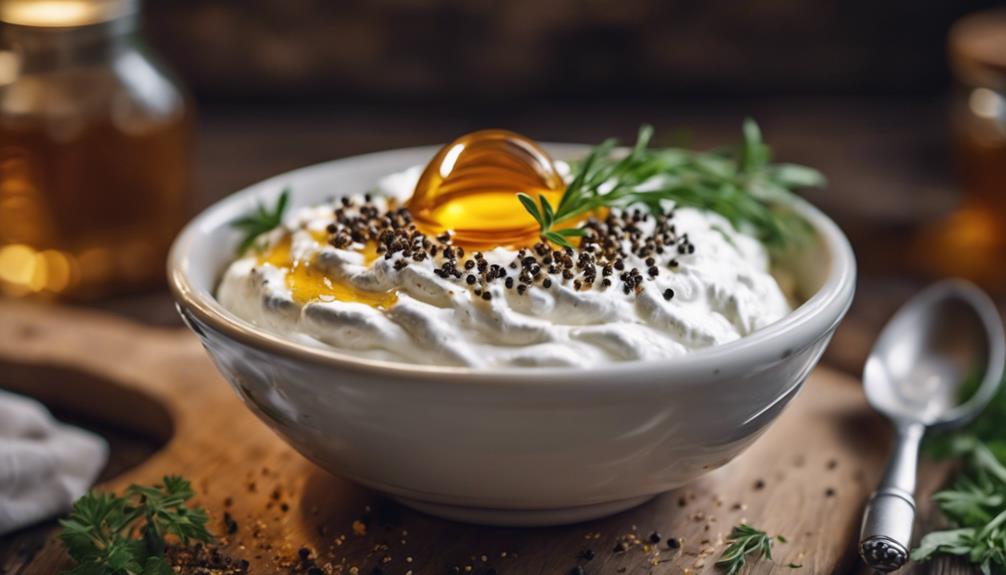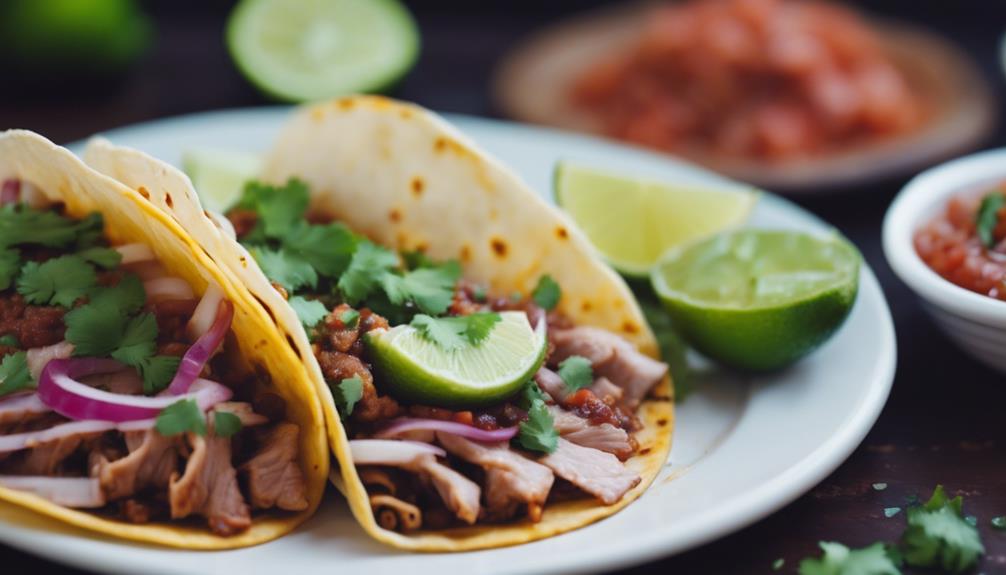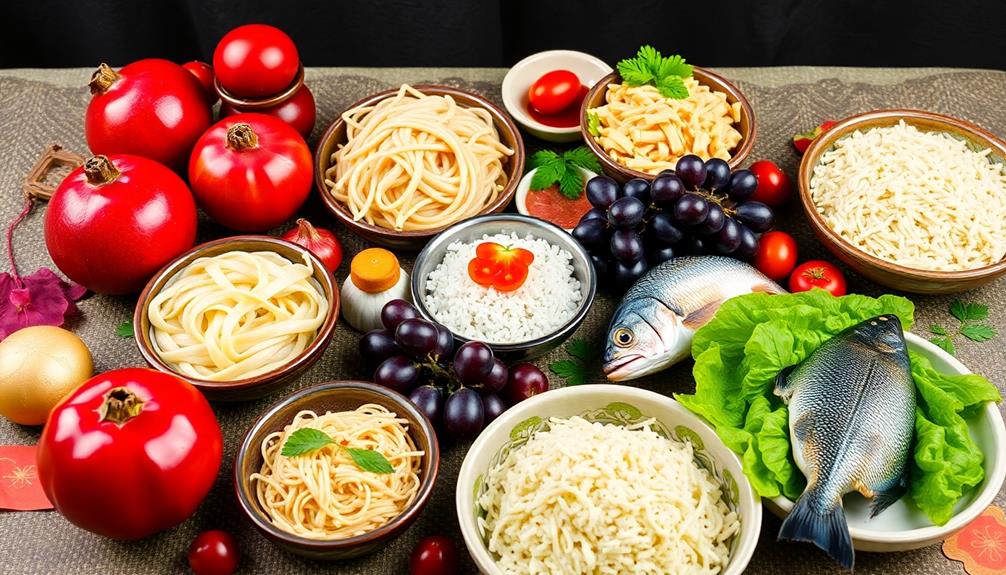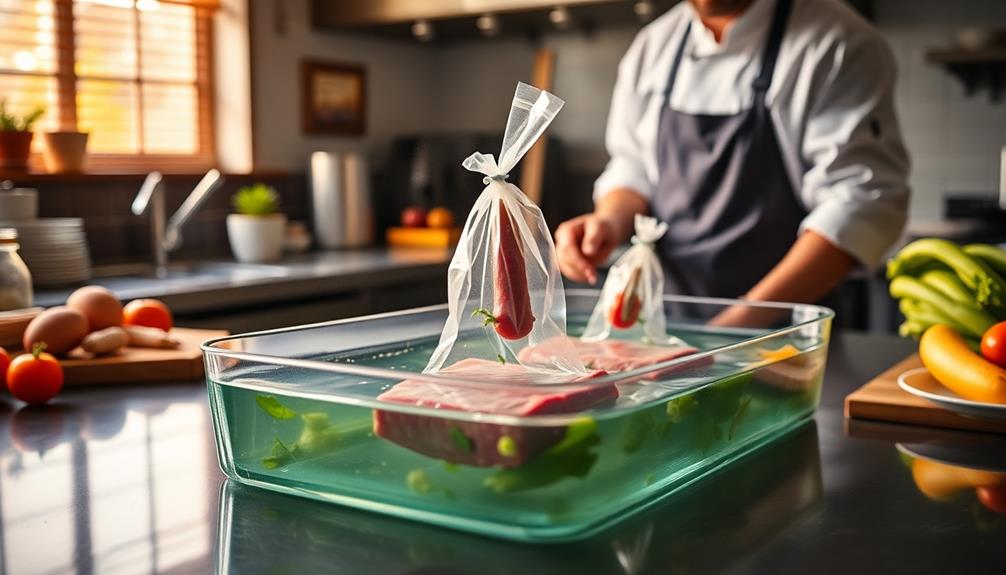Experience a delightful culinary experience with Korean Inspired Turkey Bulgogi Bowls. The marinade, made with soy sauce, sesame oil, garlic, ginger, and brown sugar, ensures juicy meat with a perfect blend of flavors. Let the ground turkey marinate for at least 30 minutes to soak up the savory, sweet, and spicy components, while the quick-pickled cucumbers provide a refreshing crunch. The Sriracha crema sauce, made with Sriracha, sour cream, lime juice, and salt, adds a spicy and creamy kick. Put together the bowls with rice, seasoned turkey, and colorful veggies, then top with sesame seeds and green onions. Keep exploring to elevate your culinary experience.
Key Takeaways
- Turkey bulgogi marinade with soy, sesame, garlic, ginger, and brown sugar for succulent flavor.
- Marinate turkey for 30 mins or overnight for enhanced taste absorption.
- Quick-pickled cucumbers offer brightness and crunch to balance the dish.
- Spicy sriracha crema sauce with sour cream and lime juice for a creamy kick.
- Top with sesame seeds, green onions, and kimchi for a flavorful finish.
Ingredients for Turkey Bulgogi Marinade
To create the flavorful marinade for your Korean-inspired Turkey Bulgogi Bowls, start by combining soy sauce, sesame oil, garlic, ginger, and brown sugar. These key ingredients are essential for guaranteeing the ground turkey with the signature savory and slightly sweet flavors characteristic of Turkey Bulgogi.
The soy sauce provides a salty base, while the sesame oil adds a nutty richness to the marinade. Garlic and ginger contribute aromatic notes and depth of flavor, enhancing the overall taste profile of the dish.
When these ingredients are combined in the right proportions, they create a harmonious blend that penetrates the turkey, resulting in a succulent and flavorful meat base for your Bulgogi Bowls.
The marriage of soy sauce, sesame oil, garlic, and ginger ensures that each bite is packed with umami goodness, making the dish a delightful experience for your taste buds.
Marinating the Ground Turkey
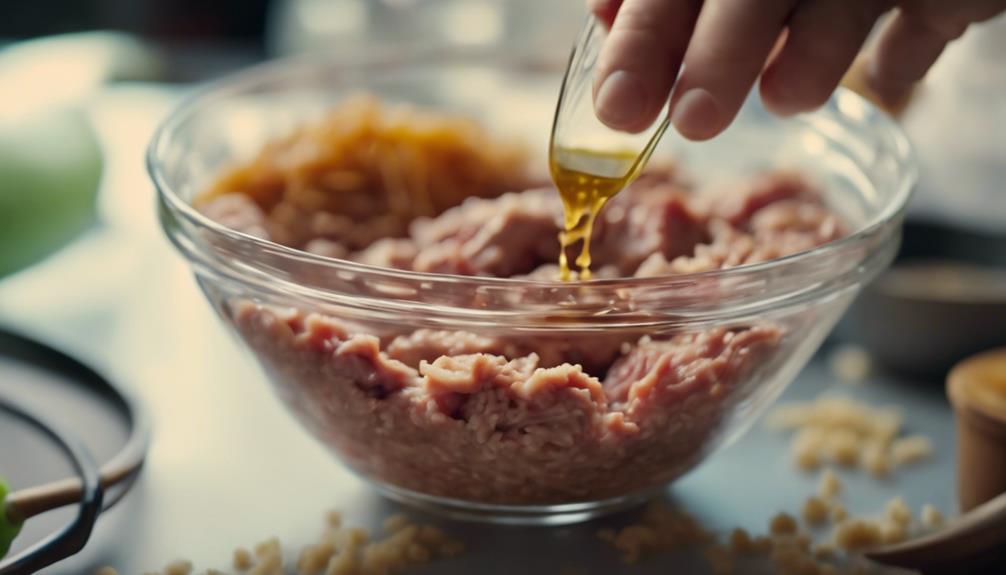
Start by placing the ground turkey in a bowl or resealable bag for marinating. This step is essential as marinating is key to developing a robust flavor profile in your dish.
By allowing the ground turkey to sit in the marinade, it absorbs the savory, sweet, and spicy elements, creating a harmonious blend of tastes.
For best results, marinate the ground turkey for at least 30 minutes, but if time permits, leaving it overnight can further enhance the flavors and tenderness of the meat.
The marinade typically consists of soy sauce, sesame oil, garlic, ginger, and brown sugar, all working together to infuse the turkey with the vibrant and authentic taste of Korean bulgogi.
Preparing the Pickled Cucumber

For a tangy and invigorating addition to your Korean-inspired turkey bulgogi bowls, consider preparing the pickled cucumbers. These cucumbers undergo a quick-pickling process, where they're submerged in a vinegar mixture. This technique imparts a bright and crunchy texture to the cucumbers, elevating the overall dish.
The acidity of the pickled cucumbers serves to balance the richness of the savory turkey bulgogi, creating a harmonious blend of flavors. Additionally, pickled cucumbers offer a customizable element to your dish; you can enhance them with ingredients like garlic, dill, or red pepper flakes to suit your taste preferences.
Making the Sriracha Crema Sauce
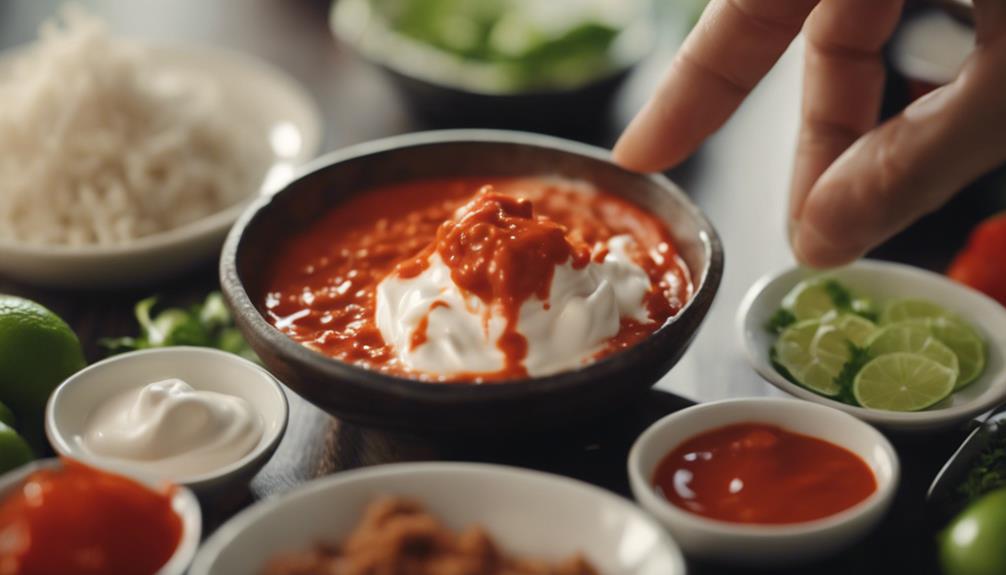
Consider enhancing your Korean-inspired turkey bulgogi bowls with a spicy and creamy element by making the Sriracha Crema Sauce. This sauce provides a perfect balance of heat from the sriracha and creaminess from the sour cream, adding depth and flavor to your dish. The tanginess from the lime juice and pinch of salt elevates the overall taste profile, creating a delightful culinary experience. The creamy texture of the sauce not only complements the spicy sriracha but also helps to cool down the heat, ensuring a harmonious blend of flavors.
To create the Sriracha Crema Sauce, mix sriracha, sour cream, lime juice, and a pinch of salt in a bowl until well combined. Once ready, drizzle this delectable sauce over your turkey bulgogi bowls to add a visually appealing and delicious finishing touch. The Sriracha Crema Sauce is the perfect addition to your dish, enhancing the overall flavor profile with its spicy and creamy goodness.
| Ingredients | Amount |
|---|---|
| Sriracha | 2 tbsp |
| Sour Cream | 1/4 cup |
| Lime Juice | 1 tsp |
| Salt | Pinch |
Cooking the Ground Turkey
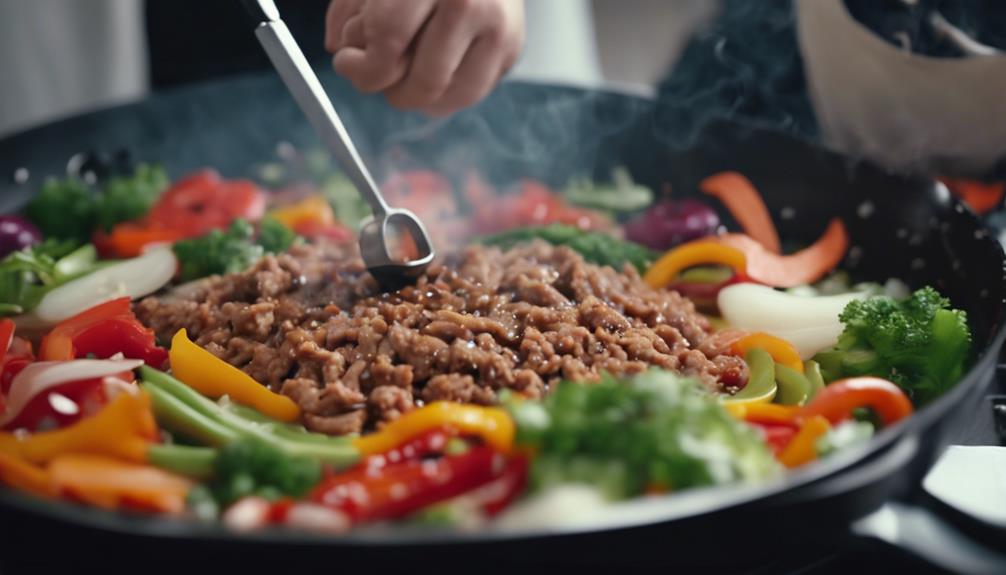
When cooking the ground turkey for your Korean Inspired Turkey Bulgogi Bowls, it's crucial to focus on browning the meat thoroughly.
Browning the turkey not only enhances its flavor but also contributes to the overall caramelized taste of the dish.
Seasoning the turkey generously during the cooking process guarantees that each bite is packed with delicious flavors.
Browning the Turkey
Start by heating a skillet over medium-high heat and adding the ground turkey to brown it for the Korean-inspired Turkey Bulgogi Bowls. Browning the turkey is an essential step in enhancing the flavor profile of the dish. As the turkey cooks, the natural juices caramelize, creating a savory and rich taste that adds depth to the overall dish. This process not only intensifies the flavor but also helps to develop a caramelized crust on the turkey, providing a delightful textural contrast. By browning the turkey, you're also aiding in rendering out excess fat, resulting in a leaner and healthier meal.
The Maillard reaction, which occurs during the browning process, is responsible for the complex and appetizing aromas that fill your kitchen. This reaction between amino acids and reducing sugars not only contributes to the appealing color of the turkey but also plays a significant role in intensifying the overall flavor profile of the Korean-inspired Turkey Bulgogi Bowls.
Seasoning for Flavor
Enhance the taste and aroma of the ground turkey by seasoning it with Korean-inspired spices and sauces like soy sauce, garlic, and ginger.
Marinating the ground turkey with these seasonings is vital to infuse the meat with savory, sweet, and spicy flavors that are characteristic of Korean cuisine. Balancing the seasoning plays a significant role in achieving a well-rounded taste profile.
It's essential to take into account the right amount of salt, sugar, and spice to create a harmonious blend of flavors that complement each other. Experimenting with different seasonings allows you to tailor the dish to your personal preference, whether you prefer a more intense flavor or a milder taste.
Stir-Frying the Vegetables

When stir-frying vegetables, it's essential to choose the right ones to maintain their crunch and nutritional value. Bell peppers, broccoli, carrots, and snap peas are commonly used due to their ability to hold up well to high heat.
Ensuring uniform cutting of the vegetables allows for even cooking and enhances the overall dish.
Vegetable Selection Tips
For vibrant and delicious stir-fried vegetables in your Korean-inspired turkey bulgogi bowls, be sure to select fresh and colorful options like bell peppers, broccoli, and snap peas.
Cutting the vegetables into uniform sizes is important to guarantee even cooking and a visually appealing presentation.
When stir-frying the vegetables, it's vital to work quickly over high heat to maintain their crisp texture and vibrant colors, enhancing the overall dish.
To add a variety of textures and flavors, consider including water chestnuts, bamboo shoots, or baby corn in the stir-fry mix.
Additionally, incorporating aromatic ingredients such as garlic, ginger, and scallions will infuse the vegetables with a rich depth of flavor.
Stir-Frying Techniques Explained
To achieve perfectly cooked and flavorful vegetables in your Korean-inspired turkey bulgogi bowls, mastering the art of stir-frying is essential. Stir-frying is a quick cooking method that involves cooking ingredients in a hot pan with a small amount of oil. Vegetables are typically cut into uniform sizes to guarantee even cooking during stir-frying. High heat is vital in stir-frying to create a nice sear on the vegetables while retaining their crisp texture. This technique allows the vegetables to retain their nutrients, colors, and flavors due to the short cooking time, perfect for creating vibrant dishes like Korean-inspired turkey bulgogi bowls. Stir-frying is a common practice in Korean cuisine to bring out the best flavors in dishes. Below is a table summarizing the key points of stir-frying techniques:
| Key Points | Description |
|---|---|
| Cooking Method | Quick cooking in a hot pan with a small amount of oil |
| Vegetable Preparation | Cutting vegetables into uniform sizes for even cooking |
| Heat Level | High heat to sear vegetables while maintaining crisp texture |
Assembling the Bulgogi Bowls
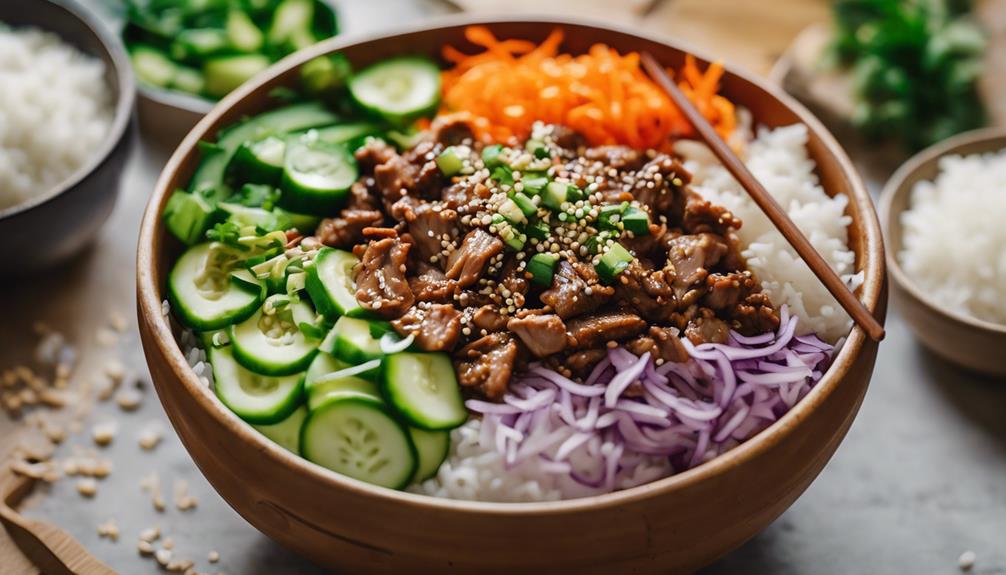
Layering cooked rice, seasoned ground turkey, and assorted vegetables in a bowl creates the foundation for assembling the Korean-inspired turkey bulgogi bowls.
The flavors in the bulgogi bowls come from the savory, sweet, and spicy marinade that coats the ground turkey.
Toppings like shredded carrots, sliced cucumbers, and green onions add vitality and crunch to the bowls.
To enhance the visual appeal and taste, consider adding sesame seeds, which provide a nutty flavor and a delightful crunch to each bite.
You can further customize your bowl by incorporating additional ingredients such as kimchi for a tangy kick, pickled radishes for a rejuvenating twist, or a drizzle of sriracha for those who crave extra heat.
Serving and Garnishing Suggestions

Enhance the overall presentation and flavor profile of your Korean-inspired turkey bulgogi bowls by considering various serving and garnishing suggestions.
Start by sprinkling sesame seeds over the bowls to add a delightful crunch and nutty flavor.
Serve the bowls generously over a bed of fluffy white rice, allowing the grains to soak up the savory bulgogi sauce, enhancing every bite with a perfect balance of textures.
For a pop of freshness and color, top your bowls with thinly sliced green onions, providing a mild onion flavor and a vibrant touch.
To elevate the experience further, offer a side of kimchi or pickled cucumbers, bringing a tangy and crunchy contrast to the rich flavors of the turkey bulgogi.
Storage Tips for Leftovers
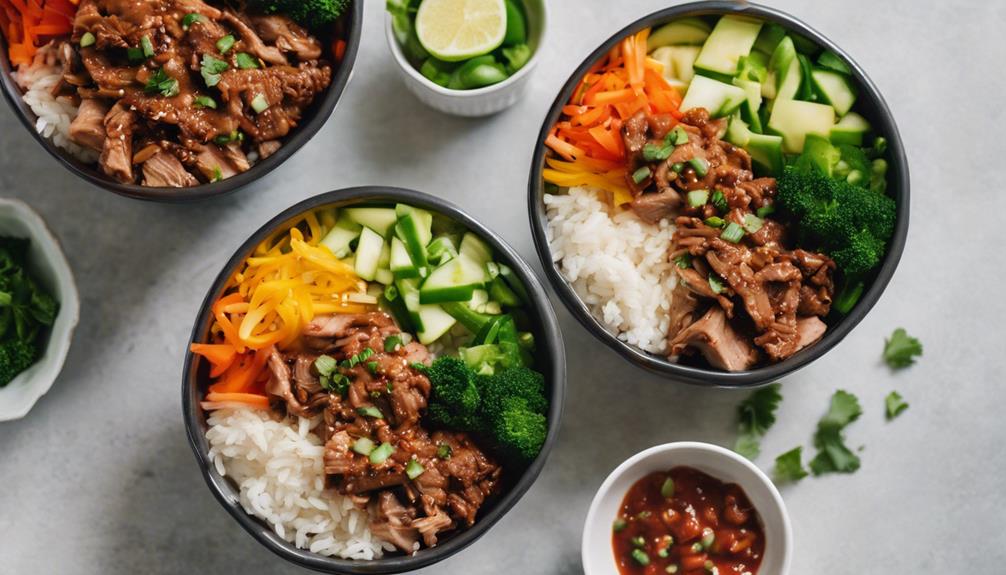
When storing your turkey bulgogi bowls leftovers, it's important to place them in airtight containers in the refrigerator to maintain their freshness.
Remember that these bowls can be refrigerated for up to 3-4 days for the best taste.
When you're ready to enjoy them again, simply reheat in the microwave or on the stovetop until heated through.
Proper Refrigeration Techniques
To guarantee food safety and prolong the freshness of your Korean-inspired turkey bulgogi bowls, store any leftovers in airtight containers in the refrigerator. Proper refrigeration techniques are essential for maintaining the quality of your meal. Here are some essential tips to make sure your leftovers stay safe and delicious:
- Refrigerate promptly: Properly cooled leftovers should be refrigerated within two hours of cooking to prevent bacterial growth and maintain freshness.
- Storage duration: Leftovers can be safely stored in the refrigerator for up to 3-4 days. After this time, it's best to discard them to avoid any potential foodborne illnesses.
- Reheat thoroughly: Before consuming your refrigerated leftovers, make sure they're reheated thoroughly to kill any bacteria present and guarantee food safety.
Reheating Instructions
For peak enjoyment of your Korean-inspired turkey bulgogi bowls, guarantee proper reheating of leftovers by following these simple instructions.
Store any leftover components of your delicious meal in an airtight container and place it in the refrigerator, where it can be kept fresh for up to 3-4 days.
When you're ready to enjoy your leftovers, use the microwave to reheat them effectively. Heat the bowl in 30-second intervals, making sure to stir in between until it's heated through evenly.
To prevent drying out, consider adding a splash of water or broth before reheating. For a crispy texture, think about reheating the components separately and assembling the bowl just before serving.
Nutritional Information and Tips
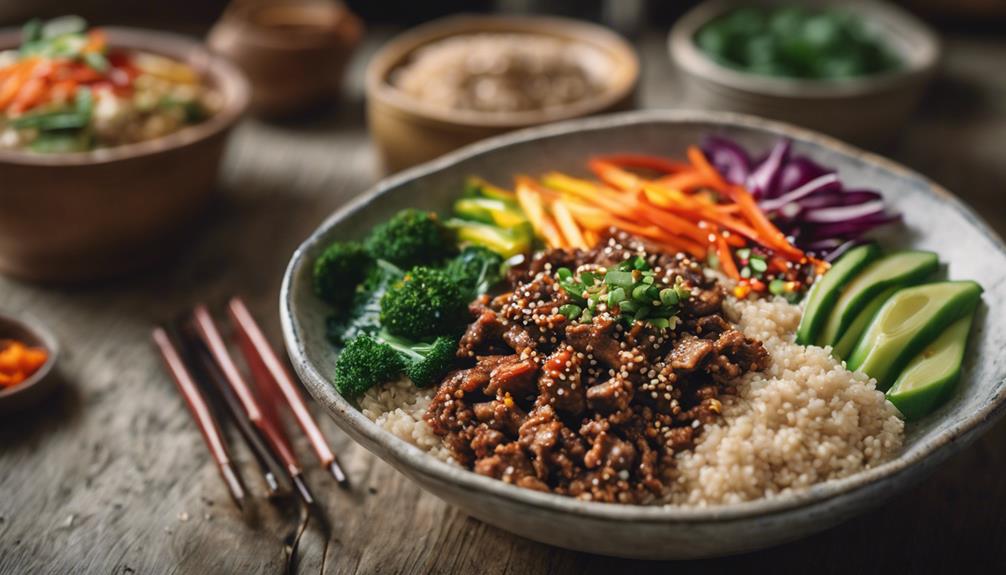
Explore the nutritional information and helpful tips for maximizing the health benefits of these Korean-inspired turkey bulgogi bowls.
The recipe for Korean Ground Turkey bowls offers a balanced meal option with only 207 calories per serving, making it a smart choice for managing your calorie intake. Additionally, the ground meat used in this dish provides a substantial 28g of protein per serving, aiding in muscle repair and satiety throughout the day.
To enhance the flavor explosion while keeping your meal lean, these bowls contain just 5g of fat and 1g of saturated fat, aligning with heart-healthy dietary recommendations.
When preparing these bowls for meal prep, consider adding extra shredded carrots and cucumber to boost the fiber content and provide a satisfying crunch to each bite. Remember, the Sriracha crema not only adds a spicy kick but also contributes to the overall sensory experience of this dish.
Frequently Asked Questions
What Does Korean Bulgogi Taste Like?
Korean Bulgogi tastes like a savory, sweet, and slightly spicy flavor explosion. The marinade blends soy sauce, sesame oil, garlic, ginger, sugar, and gochujang for a rich umami taste with a hint of heat.
What Does Bulgogi Mean in Korean?
Do you wonder what Bulgogi means in Korean? 'Bulgogi' translates to 'fire meat' in Korean, where 'bul' stands for fire and 'gogi' for meat. This flavorful dish involves marinating thinly sliced beef or pork in a delicious mix.
What Is Bulgogi Sauce Made Of?
Bulgogi sauce is made of soy sauce, sugar, sesame oil, garlic, ginger, and sometimes pear puree for sweetness and tenderness. It may also include rice vinegar, mirin, and gochujang for added depth of flavor and complexity.
Why Do Koreans Eat Bulgogi?
When Koreans eat bulgogi, they savor the perfect balance of sweet, savory, and umami flavors. It's like hitting the jackpot! This dish isn't just food; it's a cultural symbol that celebrates Korea's culinary heritage.
Can Bulgogi Bowls be Adapted to Chinese Cuisine for a Unique Fusion Dish?
Bulgogi bowls can definitely be adapted to Chinese cuisine for a unique fusion dish. By infusing the classic Korean flavors of Bulgogi with the diverse ingredients and cooking techniques of Chinese cuisine, a delicious and innovative dish can be created, offering a truly Fulin Chinese experience.
Conclusion
To sum up, these Korean-inspired turkey bulgogi bowls offer a flavorful explosion of tastes and textures. The combination of savory marinated turkey, tangy pickled cucumber, and spicy sriracha crema sauce creates a culinary masterpiece that's both satisfying and delightful.
Like a well-choreographed dance, each ingredient plays its part in creating a harmonious dish that's sure to impress your taste buds. Experience the symphony of flavors in every bite of these delicious bowls.

